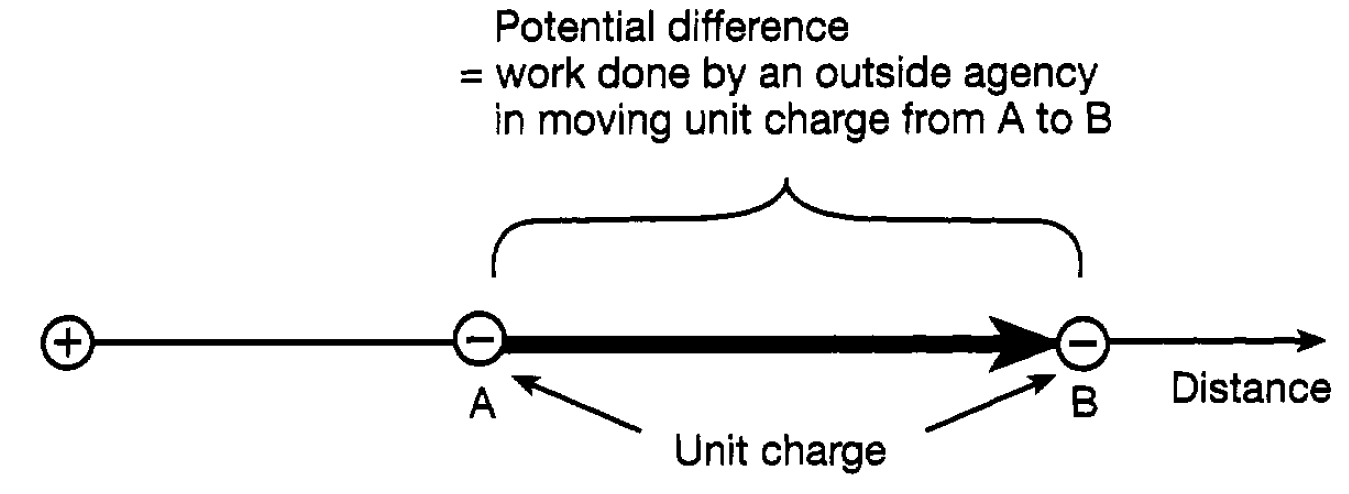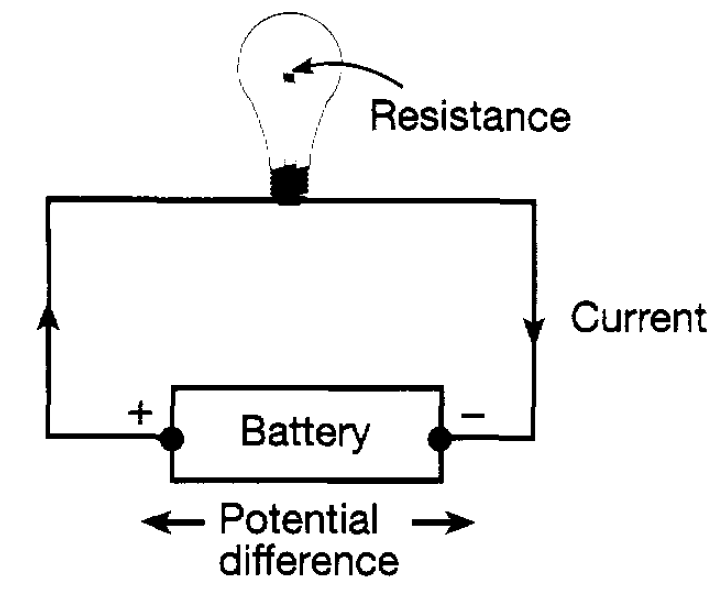


 الفيزياء الكلاسيكية
الفيزياء الكلاسيكية
 الكهربائية والمغناطيسية
الكهربائية والمغناطيسية
 علم البصريات
علم البصريات
 الفيزياء الحديثة
الفيزياء الحديثة
 النظرية النسبية
النظرية النسبية
 الفيزياء النووية
الفيزياء النووية
 فيزياء الحالة الصلبة
فيزياء الحالة الصلبة
 الليزر
الليزر
 علم الفلك
علم الفلك
 المجموعة الشمسية
المجموعة الشمسية
 الطاقة البديلة
الطاقة البديلة
 الفيزياء والعلوم الأخرى
الفيزياء والعلوم الأخرى
 مواضيع عامة في الفيزياء
مواضيع عامة في الفيزياء|
Read More
Date: 4-10-2020
Date: 3-10-2020
Date: 16-2-2017
|
Electric Potential and Electric Current
Consider a unit (i.e. 1 C) negative charge in the vicinity of a fixed positive charge as in figure 1.1. An attractive force is clearly experienced by each charge and in moving the negative charge from A to B work has to be done against the attractive force. This means that the potential energy of the negative charge has increased. The difference in the potential energy between A and B is proportional to what is known as the potential difference between the two points which is measured in volts. The potential difference is simply the work needing to be done by an outside agency to move a unit charge Potential difference

Figure 1.1: The potential difference between two points A and B.
from A to B. The volt is a unit which is familiar in everyday life from, for example, torch batteries which are usually rated at 1.5 V. Of course, if the negative charge is placed at B then, if it is free, it will move towards the positive charge under the influence of the attractive force and its potential energy will have decreased. So, to conserve energy, it will either have gained kinetic energy or have done some external work. Here it is convenient to introduce an important unit of energy which is used extensively in atomic and nuclear physics. It is known as the electron volt (denoted by eV) and is simply the amount of work which has to be done in moving one electronic charge (magnitude e = 1.602×10-19 C) through a potential difference of one volt. Its value is

where a joule (J) is the basic unit of work and energy. A battery, having a potential difference between its terminals, clearly has the ability to convey electric charge from one terminal to the other and this can be achieved if there is a suitable conduit for the moving charge. As is well known, such conduits are electric wires and connectors of one form or another (see, for example, figure 1.2).

Figure 1.2: A circuit in which current flows through a resistive light bulb.
Wires and connectors are usually made of metal and are referred to as electrical conductors. It is a property of conductors that electric charges (carried by the negatively charged electrons already mentioned) can flow through them with more or less difficulty with speeds of around 106 metres per second. This flow of electrons is referred to as an electric current and although the electrons obviously flow towards the positive terminal of a battery, since they are negatively charged, it is historical convention to speak of the current as flowing in the opposite direction. The inhibition of electron flow is due to collisions of the electrons with imperfections and impurities in the conductor. It is referred to as electrical resistance and one speaks of good conductors (e.g. copper) and bad conductors (e.g carbon) according to the size of the inhibition. For a given potential difference the size of the current (which is measured in amperes or, for short, amps the number of coulombs flowing per second) is, as might be expected, proportional to the size of this difference. It is also inversely proportional to the size of the resistance (measured in ohms). Thus, we can write (Ohm’s Law)

Of course, there are some substances, known as insulators (e.g. rubber, plastics), which do not allow electrons to flow through them at all unless the potential difference is very large indeed. In this case there is usually a violent discharge of electricity, the extreme example of this being a flash of lightning, and the insulator breaks down. As the charged electrons move through resistive material under the influence of a potential difference they experience a sort of friction and, as might be expected, this leads to the generation of heat and, sometimes, light. This is our everday experience with current flowing through the filament of an electric light bulb or the red hot wire of an electric fire. The amount of heat and light generated in unit time which, by the law of conservation of energy, is the amount of energy consumed in that time, is called power. It is the work done in unit time in conveying charge across a potential difference and, remembering our discussion above, is simply the product of the potential difference (measured in volts) and the charge transported across the potential difference in unit time (i.e. the current flow measured in amps). The value of this product is measured in watts, a unit which is familiar in specifying the power rating of domestic appliances. It may happen that the amount of heat generated by current flowing through a conductor is enough to melt it. This is precisely what happens when a fuse ‘blows’ and it is standard practice to rate fuses by the amount of current they can carry (e.g. 3,5,13 A) before melting and so breaking a circuit.



|
|
|
|
اكتشاف تأثير صحي مزدوج لتلوث الهواء على البالغين في منتصف العمر
|
|
|
|
|
|
|
زهور برية شائعة لتر ميم الأعصاب التالفة
|
|
|
|
|
|
العتبة العباسية تطلق مسابقة فن التصوير الفوتوغرافي الثانية للهواة ضمن فعاليات أسبوع الإمامة الدولي
|
|
|
|
لجنة البرامج المركزيّة تختتم فعاليّات الأسبوع الرابع من البرنامج المركزي لمنتسبي العتبة العباسيّة
|
|
|
|
قسم المعارف: عمل مستمر في تحقيق مجموعة من المخطوطات ستسهم بإثراء المكتبة الدينية
|
|
|
|
متحف الكفيل يشارك في المؤتمر الدولي الثالث لكلية الآثار بجامعة الكوفة
|